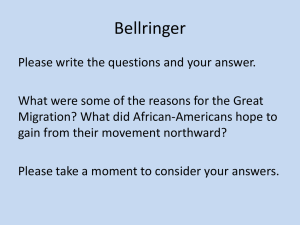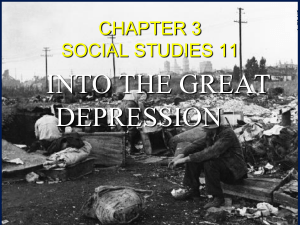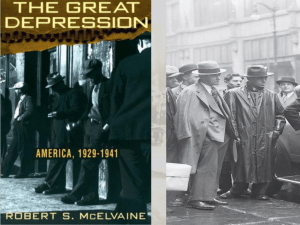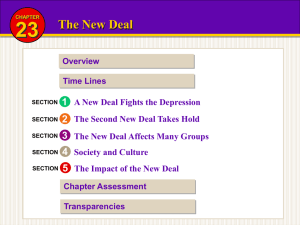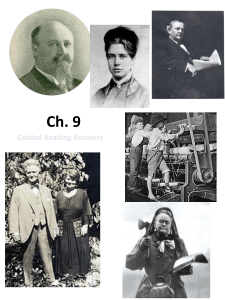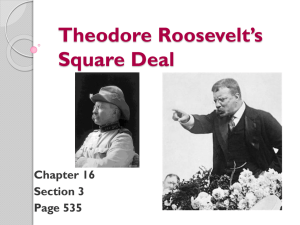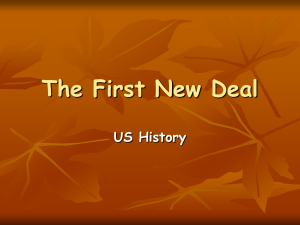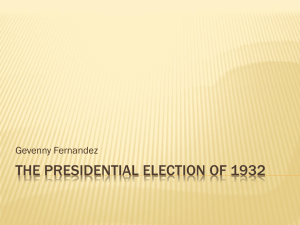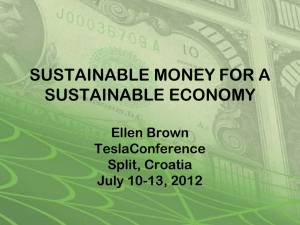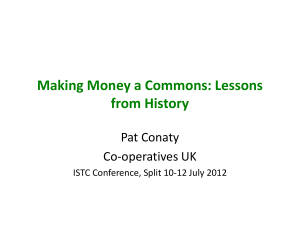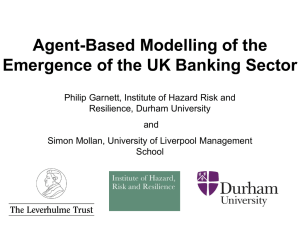Great Depression PPT
advertisement
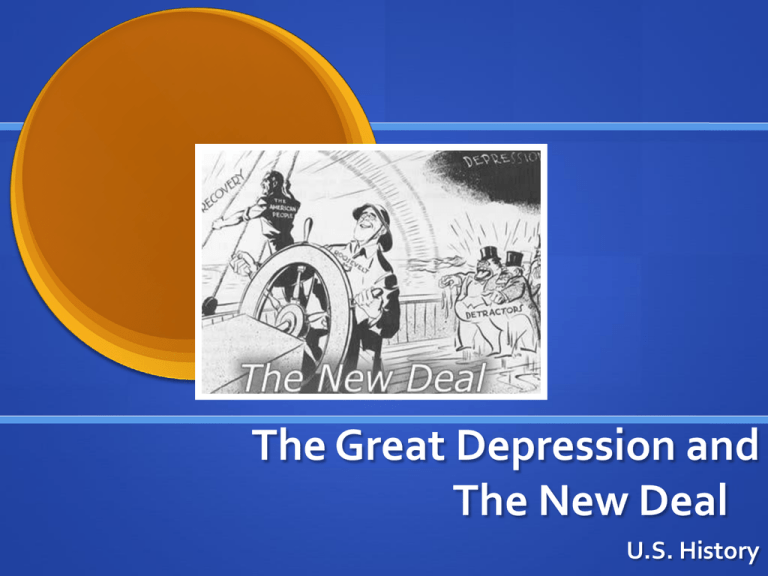
The Great Depression and The New Deal U.S. History The Crash On Monday, October 21, 1929 the stock market plunged. Frightened customers put their stocks up for sale at a frenzied pace, driving the market into a tailspin. On October 24, Black Thursday, the market plummeted further. The following week, October 29 (Black Tuesday) prices took the steepest dive, losing $10 to $15 billion dollars in stock value. By Mid-November stock prices had dropped by over 1/3. Some $30 billion was lost The stock market crash was not the major cause of the Great Depression, but it undermined the economy's ability to hold out against its other weaknesses The Great Depression The stock market crash helped put the economy into a recession. Yet the crash would not have let to a long-lasting depression if other forces had not been at work. The roots of the Great Depression were deeply entangled in the economy of the 1920’s. Causes of the Great Depression During the 1920’s, many Americans bought high cost items on the installment plan, where they would make a small down payment and pay the rest in monthly installments. Some buyers eventually were forced by debt to reduce spending on other items. This low consumption then led manufactures to cut production and lay off employees. The slowdown in retail manufacturing had repercussions throughout the economy, resulting in a chain reaction which put more and more Americans out of work. Many jobs might have been saved if American manufactures had sold more goods abroad. As the bull market of the 1920s accelerated, U.S. banks made high-interest loans to stock speculators instead of lending money to foreign companies. Without these loans from U.S. banks, foreign companies purchased fewer products from American manufacturers. The Hawley-Smoot Tariff (1930) raised the average tariff rate to the highest level in American history made a huge impact. Instead of raising interest rates to curb excessive speculation, the Federal Reserve kept its rates very low throughout the 1920s The Board’s failure to raise interest rates significantly helped cause the Depression in two ways. First, by keeping rates low, it encouraged member banks to make risky loans. Second, its low interest rates led business leaders to think the economy was still expanding, resulting in them borrowing more money to expand production, which led to overproduction when sales were falling. Then the Fed made another mistake by raising interest rates, which tightened credit which eventually helped put the company into a recession. Summery of Causes Overproduction and low demands leads to employee layoffs Low wages reduce consumer buying power High tariffs restrict foreign demand for American goods Unemployment reduces buying power further Impacts of the Great Depression Economic: The markets crash severely weakened the nation’s banks in two ways. First, many banks had lent money to stock speculators. Second, many banks had invested depositors’ money in the stock market, hoping for higher returns that they could get by using the money for conventional loans When stock values collapsed, the banks lost money on their investments, and the speculators defaulted on their loans. Many banks cut back drastically on the loans they made, with less credit available, consumers and businesses were unable to borrow as much money as they had before. This helped put the economy into a recession During the first two years of the Depression, more than 3,000 banks were forced to close. The bank failures in 1929 and early 1930 triggered a crisis of confidence in the banking system. Social: By 1933, more than 12 million workers were unemployed, about one-forth of the workforce. Average family income dropped from $2,300 in 1929 to $1,600 just three years later. People joined bread lines and soup kitchens to receive free rations of food Also, shanty towns were formed by newly homeless people, hobos, on unused or public lands. Blaming the president for their plight, people referred to such places as Hoovervilles http://docsteach.org/activities/74/pr int Hoover’s Response Hoover was seriously worried about the economy, he organized various conferences to find a solution. Hoover wanted to avoid more bank runs and layoffs by urging consumers and business leaders to become more rational in their decision making He organized a series of conferences, bringing together the heads of banks, railroads, and other big businesses, as well as labor and government officials to work to find a solution. His next step was to increase public works, government-financed building projects. Hoover also pumped money into the economy by trying to rescue banks and directly helping citizens He requested that Congress set up the Reconstruction Finance Corporation (RFC) to make loans to banks, railroads, and agricultural institutions. Congress eventually passed the Emergency Relief and Construction Act which Hoover signed on July 21st. Franklin D. Roosevelt Franklin Roosevelt (FDR) was born in 1882 to a wealthy New York family and later educated at Harvard and Columbia Law School. In 1910, he won a seat in the New York State Senate, where he earned a reputation as a Progressive reformer willing to stand up to the party bosses. In 1928 he won the position of Governor of New York. His popularity in there paved the way for his presidential nomination in 1932 where he won the campaign and implemented the New Deal First Inaugural Speech: http://historymatters.gmu.edu/d/5057 / Eleanor Roosevelt http://www.time.com/ti me/photogallery/0,2930 7,1906747,00.html The New Deal The New Deal altered permanently the roles of American government in the economy. It also fostered changes in people’s attitudes toward government’s responsibilities. Organized labor acquired new rights, as the New Deal set in place legislation that reshaped modern American capitalism. First 100 Days Between March 9 and June 16, 1933 (Hundred Days) Congress passed 15 major acts to meet the economic crisis, setting a pace for new legislations that had never been equaled. Together, these programs made up what would later be called the First New Deal. The New Deal was not based on a clear strategy or a philosophical platform. The First New Deal The first thing President Roosevelt had to do was to restore confidence in the banking system. Roosevelt agreed with the Securities Act of 1933 and the GlassSteagall Banking Act. The Securities Act required companies that sold stocks and bonds to provide complete and truthful information to investors The next year Congress created the Securities and Exchange Commission, to regulate the stock market and prevent fraud The Federal Deposit Insurance Corporation was created to provide government insurance for bank deposits up to a certain amount, which also increased confidence in the banking system. Second Step The Agricultural Adjustment Act that Roosevelt asked Congress to pass was based on a simple idea that prices for farm goods were low because farmers grew too much food. Under the program, the government would pay farmers not to raise certain crops, the farm program was administered by the Agricultural Adjustment Administration (AAA). Roosevelt and Congress also enacted the National Industrial Recovery Act (NIRA) which suspended the antitrust laws and allowed business, labor, and government to cooperate in setting up voluntary rules for each industry. Third Step President Roosevelt introduced several policies that intended to assist Americans with their debts. He asked Congress to establish the Home Owners’ Loan Corporation which bought the mortgages of many homeowners who were behind in their payments. Congress also authorized the Farm Credit Administration to begin helping farmers refinance their mortgages. Fourth Step Roosevelt urged Congress to establish a series of government agencies that would organize work programs for the unemployed. The most highly praised New Deal work relief program was the Civilian Conservation Corps which offered unemployed young men the opportunity to work under the direction of national forestry service planting trees, fighting forest firs, and building reservoirs. In June 1933, Congress authorized the creation of another federal relief agency, the Public Works Administration (PWA) which began a series of construction projects to build and improve government facilities. The Second New Deal The New Deal had been in effect for two years, yet the economy had shown only a slight improvement. President Roosevelt launched what came to be called the Second New Deal, another series of programs and reforms that he hoped would speed up the nation’s recovery, provide economic security to every American, and ensure his re-election in 1936. In January 1935, Roosevelt began by asking Congress for nearly $5 billion, much of the money would be given to the Works Progress Administration, a new federal agency headed by Harry Hopkins. The Federal Theater Project financed various elements to the theater. Congress began work on a bill that ranks as one of the most important pieces of legislation in American History, the Social Security Act. Its major goal was to provide some security for the elderly and for unemployed workers. Programs of the First New Deal Agricultural Adjustment Act (AAA) Reduced agricultural surplus and raised prices for struggling farmers Federal Deposit Insurance Corporation (FDIC) Guaranteed bank deposits to $2,500. Civilian Conservation Corps (CCC) Employed single men, ages 1825, for natural resource conservation Securities and Exchange Commission (SEC) Regulated the stock market to avoid dishonest practices Public Works Administration (PWA) Civil Works Administration (CWA) Provided employment in construction of airports, parks, schools, and roads Programs of the Second New Deal Works Progress Administration (WPA) Combated unemployment; created jobs throughout economy Social Security Act Coated an unemployment system, disability insurance, old-age pension , and child welfare benefits Rural Electrification Administration (REA) Brought electricity to isolated agricultural areas Resettlement Act Assisted poor families and sharecropping in beginning new farms or purchasing land Impact of the New Deal •Various new acts enabled people to once again find work (Public Works Admin. Federal Emergency Relief) •A Social “Safety Net” was created with the Social Security Act which provided income for elderly, handicapped, and unemployed and supplied a monthly retirement benefit for people over 65 •Women and African Americans gained political recognition •The government took on a new role, expanded its influence, and increased its power over the economy •Put new rules on banks, brokers, and the stock market, while other programs placed new regulations on industrial production and prices, downsized agricultural surplus and raised farm profits, and granted federal relieve efforts. Criticisms of the New Deal In the election of 1936, Governor Alfred Landon became the Republican nominee. He stated that the New Deal “violates the basic ideals of the American system…If we are to preserve our American form of government, this administration must be defeated.” Critics, like Huey Long who headed the Union Party, continued to agree that the New Deal made the government too powerful and made the American people too dependent on government spending. Legacy of the New Deal In terms of its main goal of ending the Depression, the New Deal was only a limited success. Even so, the New Deal gave many Americans a stronger sense of security and stability. As a whole, the New Deal tended to operate so that it balanced competing economic interests. The Federal Government’s ability to take on this new role was enhanced by two important supreme court decisions. The New Deal established what some have called the broker state, working out conflicts among different interests, which has continued under the administration of both parties ever since. Probably the biggest change the New Deal brought about was the new public attitude toward government. The American people now felt that the government had a duty to maintain this safety net even though it required a larger, more expensive federal government that at any time in American History. End of the New Deal The Recession of 1937 enabled the Republicans to win many seats in Congress in the midterm elections of 1938, turning the Democratic majority against the New Deal. Together with conservative Southern Democrats, they began blocking further New Deal Legislation Roosevelt, meanwhile, became increasingly preoccupied with the growing international threat posed by Germany and Japan By 1939 the New Deal era had come to an end.

